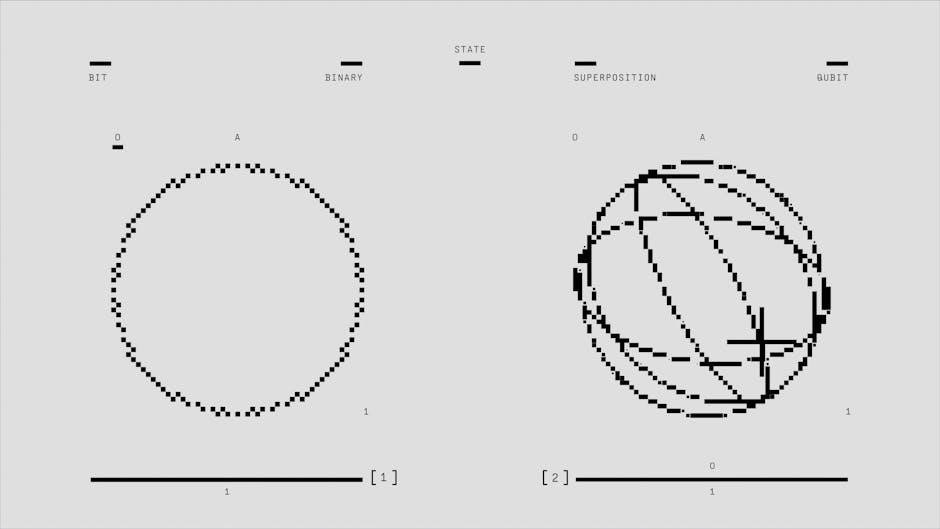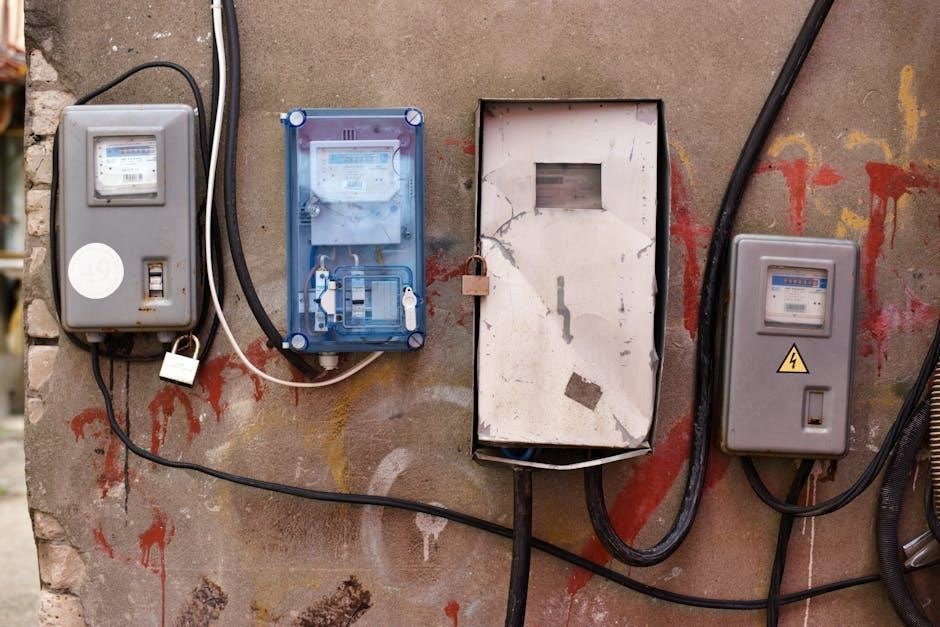The Freightliner Fuse Box Diagram PDF is a comprehensive guide detailing electrical circuits, fuse locations, and wiring schematics for Freightliner trucks, essential for mechanics and drivers.
1.1 Overview of the Fuse Box Diagram
The Freightliner Fuse Box Diagram provides a comprehensive visual guide to the electrical system, detailing fuse locations, wiring schematics, and circuit protection. It identifies key components like fuses, relays, and circuit breakers, ensuring quick troubleshooting and repairs. This diagram is essential for maintaining and repairing Freightliner trucks, offering a clear layout of the electrical setup for various models, including Cascadia and M2; It helps users identify issues efficiently and ensures smooth operation of electrical systems.
1.2 Importance of the Fuse Box Diagram for Vehicle Maintenance
The Freightliner Fuse Box Diagram is crucial for maintaining electrical systems, enabling quick identification of blown fuses and circuit issues. It prevents minor problems from escalating, ensuring safety and efficiency. By guiding proper repairs and inspections, it helps avoid costly downtime. Regular use of the diagram promotes proactive maintenance, preventing electrical failures and extending vehicle lifespan. It is indispensable for both routine checks and complex diagnostics.
Components of the Freightliner Fuse Box
The Freightliner Fuse Box consists of fuses, relays, circuit breakers, and wiring diagrams, each serving specific roles in regulating and protecting the vehicle’s electrical systems effectively.
2.1 Understanding the Layout of the Fuse Panel
The Freightliner fuse panel is meticulously organized, with fuses, relays, and circuit breakers arranged to simplify identification and maintenance. The layout typically includes labeled slots for each fuse, corresponding to specific electrical systems like headlights or interior lights, ensuring easy access for diagnostics and repairs. This structured design helps drivers and technicians quickly locate and address electrical issues, enhancing overall vehicle reliability and safety.
2.2 Key Components: Fuses, Relays, and Circuit Breakers
Fuses protect electrical circuits from overcurrent, relays control power distribution, and circuit breakers provide resettable protection. Each component is crucial for maintaining the Freightliner’s electrical system, ensuring safe and efficient operation. Fuses are rated for specific currents, relays enable remote control of accessories, and circuit breakers offer reusable protection, combining to safeguard the vehicle’s electrical infrastructure and prevent potential damage or malfunctions.

Location of the Fuse Box in Different Freightliner Models
The fuse box in Freightliner models varies by design. For Cascadia, it’s under the dash; in M2, it’s on the driver’s side. Locations differ by model.
3.1 Fuse Box Location in Freightliner Cascadia
In the Freightliner Cascadia, the fuse box is typically located under the dashboard on the driver’s side. This central position allows easy access for maintenance and repairs.
3.2 Fuse Box Location in Freightliner M2
In the Freightliner M2, the fuse box is typically located under the dashboard on the driver’s side, near the steering column. Accessing it may require removing the lower dash panel. The exact location can vary slightly by model year, so consulting the vehicle’s manual or diagram is recommended for precise identification and easy access during maintenance or repairs.

How to Read the Freightliner Fuse Box Diagram
Understand the layout and symbols in the Freightliner Fuse Box Diagram PDF. Identify fuse numbers, labels, and corresponding circuits to troubleshoot or repair electrical systems effectively.
4.1 Identifying Fuse Numbers and Their Functions
Identify fuse numbers by locating the designated labels on the fuse panel. Each fuse corresponds to specific electrical components, such as headlights or panel lights. Refer to the Freightliner Fuse Box Diagram PDF to match fuse numbers with their respective functions, ensuring accurate diagnostics and repairs. This step is crucial for effective troubleshooting and maintaining vehicle performance. Use the guide to avoid misidentification and potential damage to electrical systems. Always cross-check with the provided wiring diagrams for precise information. Regular inspection of fuses and their functions helps prevent unexpected electrical failures. Understanding this process ensures safe and efficient electrical system maintenance; By following the diagram, users can quickly pinpoint issues and resolve them without unnecessary delays or complications. This knowledge is essential for both professional mechanics and DIY enthusiasts working on Freightliner vehicles. Proper identification of fuse functions minimizes the risk of incorrect repairs and enhances overall vehicle reliability. Stay informed and refer to the PDF regularly for updated information and detailed instructions. Safe and effective fuse management begins with a thorough understanding of each fuse’s role in the electrical system. Utilize the Freightliner Fuse Box Diagram PDF to streamline your maintenance routine and ensure optimal vehicle operation.
4.2 Understanding Wiring Diagrams and Schematics
Wiring diagrams and schematics provide a visual representation of electrical circuits, showing how components like fuses, relays, and wires connect. Symbols, such as circles for fuses and lines for wires, help interpret the diagram. Complex circuits may require careful study to trace connections. Referencing the Freightliner Fuse Box Diagram PDF ensures accuracy. Understanding these diagrams is key to diagnosing and repairing electrical issues efficiently, as they reveal how power flows through the system. By analyzing wiring schematics, users can identify faults, such as blown fuses or short circuits, and determine the correct repair steps. This knowledge enhances troubleshooting precision and reduces downtime. Always cross-check diagrams with the actual fuse panel to confirm connections. Proper interpretation of wiring diagrams is essential for maintaining electrical system integrity and ensuring safe, reliable vehicle operation. Use the Freightliner Fuse Box Diagram PDF as a guide to navigate complex wiring layouts confidently. Regular review of these diagrams improves familiarity with the electrical system, aiding in quicker repairs and minimizing errors. This understanding is vital for both routine maintenance and unexpected electrical issues. By mastering wiring diagrams, users can address problems effectively and keep their Freightliner running smoothly. Detailed schematics provide the clarity needed for accurate diagnostics and repairs, making them an indispensable resource for vehicle maintenance.

Troubleshooting Common Electrical Issues
Identify blown fuses, faulty relays, or short circuits using the Freightliner Fuse Box Diagram PDF. This guide helps diagnose issues like malfunctioning lights or electrical systems, ensuring quick repairs.
5.1 Identifying Blown Fuses and Their Causes
Blown fuses in Freightliner trucks often result from overloaded circuits, short circuits, or faulty components. The fuse box diagram helps locate and identify affected fuses, ensuring precise troubleshooting. Regular inspection and adherence to the diagram’s guidelines minimize electrical issues, while understanding common causes aids in preventing future occurrences and maintaining optimal vehicle performance safely.
5.2 Using the Diagram for Diagnostic Purposes
The Freightliner Fuse Box Diagram PDF serves as an essential tool for diagnosing electrical issues; It provides a detailed layout of the fuse box, allowing you to identify which fuse corresponds to a specific circuit. When experiencing electrical problems, such as malfunctioning headlights or accessories, refer to the diagram to locate the relevant fuse. Inspect the fuse visually for signs of damage or use a multimeter to test its continuity. If a fuse is blown, replace it with one of the same amperage rating. The diagram also aids in tracing wiring and understanding circuit connections, helping you identify underlying issues like shorts or overloads. Additionally, it may include information on circuit breakers and relays, which are crucial for more complex diagnostics. Always ensure you have the correct diagram for your specific Freightliner model to avoid confusion. Prioritize safety by disconnecting the battery before working on the fuse box. Utilize tools like a fuse puller or multimeter to facilitate accurate diagnoses. By leveraging the diagram effectively, you can efficiently pinpoint and resolve electrical problems, ensuring your truck’s systems operate smoothly and reliably. Regular use of the diagram enhances your ability to troubleshoot and maintain your vehicle’s electrical health proactively.

Maintenance Tips for the Fuse Box
Regularly inspect the fuse box for signs of wear or corrosion. Clean connections to ensure proper conductivity. Use a multimeter to test fuses and circuit breakers. Replace blown fuses with the correct amperage rating to prevent damage. Refer to the Freightliner Fuse Box Diagram PDF for accurate repairs and maintenance.
6.1 Cleaning and Inspecting the Fuse Panel
Disconnect the battery before cleaning. Use compressed air to remove dust and debris from the fuse panel. Inspect fuses for signs of corrosion or damage. Check for loose connections and tighten them if necessary. Verify proper conductivity by testing fuses with a multimeter. Refer to the Freightliner Fuse Box Diagram PDF for guidance on identifying and addressing potential issues during inspection.
6.2 Replacing Fuses Safely and Correctly
Always disconnect the battery before replacing fuses to prevent electrical shocks or short circuits. Use the Freightliner Fuse Box Diagram PDF to identify the correct fuse and its rating. Replace blown fuses with ones of the same amperage rating to avoid damaging the electrical system. Ensure the new fuse is securely seated and test the affected circuit to confirm proper function.
Downloading the Freightliner Fuse Box Diagram PDF
To download the Freightliner Fuse Box Diagram PDF, visit the official Freightliner website or contact an authorized dealership for the correct document. Ensure the PDF matches your vehicle model for accuracy and safety. Avoid unofficial sources to prevent downloading incorrect or outdated information.
7.1 Reliable Sources for the PDF Document
Obtaining the Freightliner Fuse Box Diagram PDF from trusted sources is crucial. Visit Freightliner’s official website or contact authorized dealerships for authentic documents. Additionally, reputable automotive forums and repair shops often provide verified links to the PDF. Ensure the source is reliable to avoid incorrect or outdated information, which could lead to improper repairs.
7.2 Ensuring the Diagram Matches Your Vehicle Model
Always verify that the Freightliner Fuse Box Diagram PDF corresponds to your specific vehicle model. Check the document’s title or introduction for model compatibility, such as Freightliner Cascadia or M2. Cross-referencing with your truck’s VIN or year ensures accuracy. Using the wrong diagram can lead to incorrect repairs and potential safety hazards.

Safety Precautions When Working with the Fuse Box
- Always disconnect the battery before accessing the fuse box to prevent electrical shocks.
- Use proper tools to avoid damaging fuses or the panel.
- Wear safety gear, including gloves and goggles, for protection.
- Consult the vehicle’s manual before making any modifications.
8.1 Proper Safety Gear and Tools
When working with the Freightliner fuse box, wear safety gear like insulated gloves and goggles to prevent electrical shocks. Use a multimeter to test circuits and ensure components are de-energized. Keep a set of screwdrivers and pliers handy for safe fuse removal. Always disconnect the battery first to avoid live electrical currents. Proper tools and precautions protect both you and the vehicle’s electrical system from damage.
8.2 Disconnecting the Battery Before Repairs
Always disconnect the battery before working on the Freightliner fuse box to ensure safety. Start by locating the negative terminal, then loosen the bolt and slide the cable off. This prevents accidental short circuits and protects the electrical system. Use a wrench for secure disconnection. Never skip this step, as it safeguards against electrical shocks and potential damage to the vehicle’s electronics.

Interpreting Wiring Diagrams for Advanced Troubleshooting
Understanding wiring diagrams is essential for advanced troubleshooting. These diagrams provide detailed visuals of electrical circuits, helping identify components and connections. They are crucial for diagnosing complex issues efficiently.
9.1 Understanding Circuit Symbols and Codes
Mastering circuit symbols and codes is vital for interpreting wiring diagrams. Standard symbols represent components like fuses, relays, and connectors, ensuring clarity. Codes often indicate wire colors or functions, aiding in tracing circuits. This knowledge helps technicians quickly identify and diagnose issues, streamlining repairs and reducing downtime for Freightliner trucks.
9.2 Using the Diagram to Trace Electrical Circuits
The Freightliner fuse box diagram provides a visual layout of electrical circuits, enabling technicians to trace wiring paths efficiently. By following labeled connections and symbols, issues like blown fuses or short circuits can be pinpointed. This systematic approach ensures accurate diagnostics, reducing repair time and preventing further damage to the vehicle’s electrical system.

DIY Repairs Using the Fuse Box Diagram
The Freightliner fuse box diagram offers step-by-step guidance for DIY repairs, enabling users to troubleshoot and replace components efficiently, ensuring safe and effective electrical system maintenance.
10.1 Step-by-Step Guide to Replacing Components
The Freightliner fuse box diagram provides a detailed, step-by-step guide for replacing components, ensuring DIY repairs are performed safely and correctly. Start by identifying the faulty fuse or relay using the diagram. Next, disconnect the battery to prevent electrical shocks. Carefully remove the blown fuse or damaged relay, then install the new one, matching the amperage rating specified in the manual. Finally, reconnect the battery and test the affected system to verify proper functionality. This methodical approach minimizes errors and ensures reliable electrical system operation. Always refer to the PDF for specific instructions tailored to your vehicle model, as procedures may vary slightly between different Freightliner models. Proper tools and safety gear, such as insulated pliers and protective eyewear, should be used throughout the process to avoid accidents. By following these steps, you can effectively replace components and maintain your truck’s electrical system in optimal condition. Additionally, consulting the wiring diagrams within the PDF can help trace circuits and confirm connections, further aiding in successful repairs. This comprehensive guide empowers owners to handle common electrical issues confidently, reducing downtime and maintenance costs. Regular practice and familiarity with the diagram will enhance your troubleshooting skills, making future repairs quicker and more efficient. Remember, if a problem persists after replacement, it may indicate a deeper issue requiring professional attention. Always prioritize safety and accuracy when working with electrical systems to prevent further damage or hazards. With the Freightliner fuse box diagram as your reference, you can tackle component replacements with confidence, ensuring your vehicle remains in peak operational condition.
10.2 Verifying Repairs with the Diagram
After replacing components, use the Freightliner fuse box diagram to verify repairs. Cross-reference the diagram to ensure all connections and fuses are correctly restored. Test the system to confirm functionality. This step prevents overlooked issues and ensures safety. Regular verification helps maintain electrical integrity and prevents future breakdowns. Always follow the PDF guide for accurate results and reliable operation.

Understanding the Circuit Protection System
The Freightliner fuse box diagram PDF explains how fuses and relays protect electrical circuits from overloads. It details how the system safeguards components and prevents damage.
11.1 How Fuses Protect Electrical Circuits
Fuses act as critical protectors in Freightliner electrical systems, designed to interrupt power when an overload is detected. By blowing during surges, fuses prevent damage to wiring and components, ensuring system safety and reliability. This function is vital for maintaining the integrity of the vehicle’s electrical circuits, as outlined in the fuse box diagram PDF.
11.2 The Role of Relays in the Fuse Box
Relays within the Freightliner fuse box act as electronic switches, controlling high-current circuits safely. They amplify low-power electrical signals, enabling components like lights or wipers to function without overloading the system. The fuse box diagram PDF highlights relays’ locations and roles, ensuring proper diagnostics and efficient operation of various vehicle systems. This setup enhances reliability and simplifies troubleshooting electrical issues in Freightliner trucks.
When to Consult a Professional
Consult a professional if you encounter complex electrical issues, multiple blown fuses, or advanced system malfunctions that require specialized tools and expertise for accurate diagnosis and repair.
12.1 Signs of Complex Electrical Issues
Signs of complex electrical issues include recurring blown fuses, multiple circuit failures, unpredictable system behavior, and illuminated warning lights on the dashboard. These indicators suggest deeper problems beyond simple fuse replacement, often requiring advanced diagnostic tools and expertise to identify and resolve effectively. Consulting a professional is crucial in such cases to prevent further damage and ensure safety.
12.2 Benefits of Professional Diagnosis
Professional diagnosis offers precise identification of electrical issues, ensuring repairs are done correctly and efficiently. Experts utilize advanced tools and their extensive knowledge to troubleshoot complex problems, preventing further damage and enhancing vehicle reliability. Their involvement guarantees safety, reduces downtime, and provides peace of mind, especially for critical systems requiring specialized attention.
Common Mistakes to Avoid
Avoiding improper fuse replacements and ignoring safety protocols are crucial. Using incorrect fuse ratings or neglecting battery disconnection can lead to electrical fires or system damage.
13.1 Incorrect Fuse Replacement
Incorrect fuse replacement is a common mistake that can cause electrical malfunctions or even fire hazards. Using a fuse with the wrong amp rating can overload circuits, leading to system failures. Always refer to the Freightliner Fuse Box Diagram PDF to ensure the correct fuse is installed, preventing potential damage and ensuring safety.
13.2 Overlooking Safety Guidelines
Overlooking safety guidelines when working with the fuse box can lead to electrical shocks, injuries, or further damage. Always disconnect the battery and wear proper protective gear. Neglecting these precautions can result in serious harm or system malfunctions. Ensure all safety measures are followed to maintain personal and vehicle safety while performing repairs or inspections.

Evolution of Fuse Box Technology
Modern fuse boxes feature advanced designs with improved reliability, digital integration, and smarter circuit protection, enhancing safety and efficiency in Freightliner vehicles compared to older models.
14.1 Modern Advancements in Fuse Box Design
Modern Freightliner fuse boxes feature enhanced designs with digital integration, automated circuit monitoring, and high-quality materials, improving reliability and safety. These advancements simplify troubleshooting and ensure optimal electrical system performance, reducing downtime and maintenance costs for drivers and fleets.
14.2 Future Trends in Electrical Systems
Future trends in Freightliner electrical systems include smart fuses, real-time diagnostics, and integration with IoT. These innovations will enhance monitoring, reduce manual inspections, and improve overall efficiency. Advanced materials and automated systems aim to increase safety and reduce maintenance, aligning with industry demands for smarter, more reliable vehicles.
The Freightliner Fuse Box Diagram PDF is essential for efficient troubleshooting, maintenance, and safety. It provides clear guidance, ensuring drivers and mechanics can diagnose issues quickly and accurately.
15.1 Summary of Key Points
The Freightliner Fuse Box Diagram PDF is a vital resource for understanding electrical systems, ensuring safe repairs, and maintaining optimal vehicle performance. It provides detailed layouts, circuit protection information, and troubleshooting guidance. By following the diagram, users can identify and resolve issues efficiently, prevent damage, and ensure compliance with safety standards. Regular maintenance and proper fuse replacement are emphasized to uphold reliability and functionality.
15.2 Final Tips for Using the Fuse Box Diagram Effectively
Always cross-reference the diagram with your vehicle’s specific model and year for accuracy. Use proper tools to avoid damage during repairs. Regularly inspect and clean the fuse box to prevent issues. Keep a spare set of fuses handy for quick replacements. Refer to the diagram for preventive maintenance to ensure all systems function optimally and safely.
